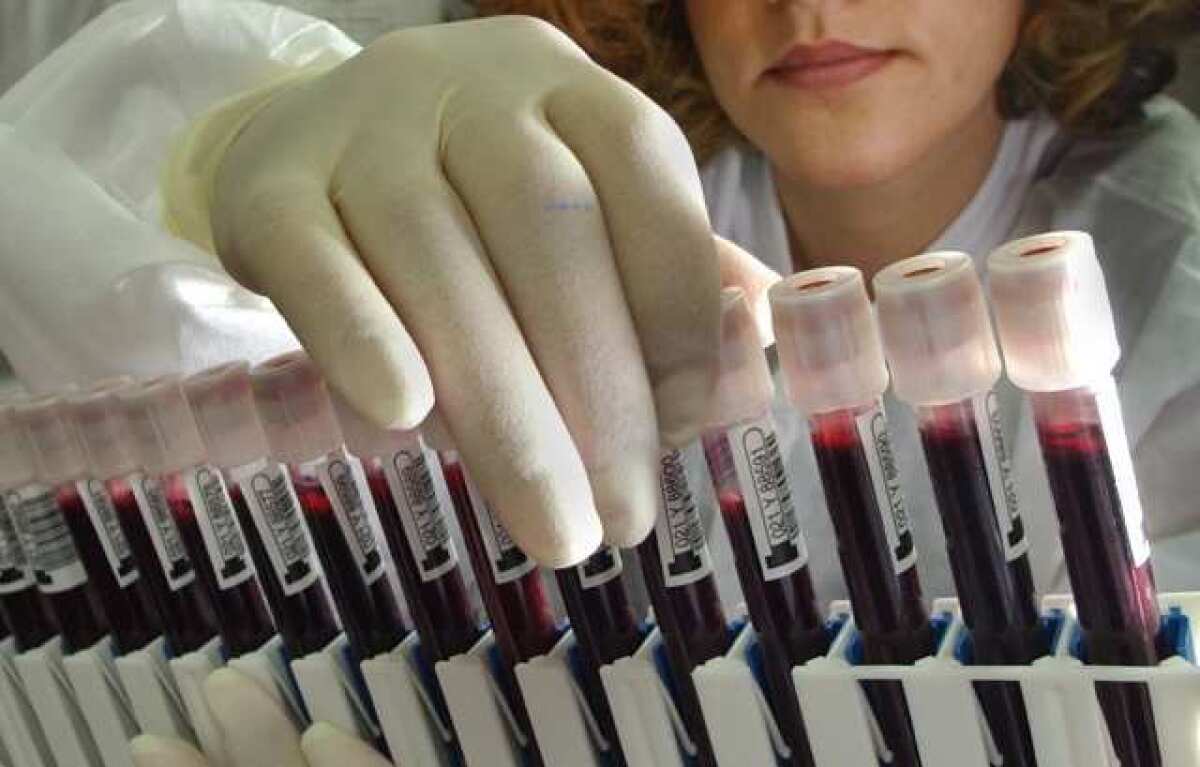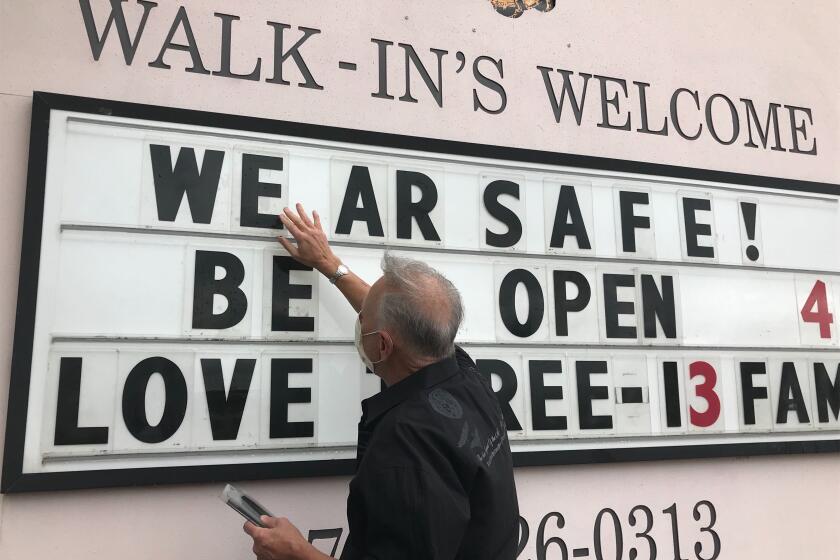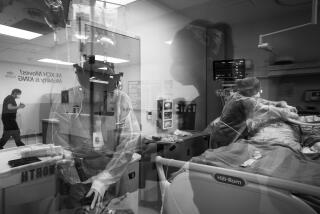COVID-19 and blood type: What’s the link?

- Share via
If there’s one thing we want to know about COVID-19, it’s probably this: What’s my risk of getting it?
Researchers have identified certain things that make some people more vulnerable than others. Men are at greater risk than women. Older people are at greater risk than younger people. Those with chronic health problems like Type 2 diabetes, obesity and serious heart conditions are faring worse than those without them. Black and Latino Americans are at greater risk than Asian Americans and whites.
Now there’s evidence that blood type could be a risk factor too.
A handful of studies have suggested that people with some blood types are more likely to be hospitalized with COVID-19, while those with other blood types are less likely to require that level of care. The most recent evidence was published last month in the New England Journal of Medicine.
Here’s a look at what scientists have learned about blood type and its role in the COVID-19 pandemic.
How many blood types are there?
Eight. Yours is determined in part by the presence (or absence) of A and B antigens on your red blood cells. If you have only A antigens, your blood type is A. If you have only B antigens, your blood type is B. If you have both, your blood type is AB, and if you have neither, your blood type is O.
In addition, red blood cells may have a protein called Rh factor. If you have it, you’re Rh positive; if not, you’re Rh negative.
The combination of A and B antigens and the Rh factor produces the eight major blood types: A-positive, A-negative, B-positive, B-negative, AB-positive, AB-negative, O-positive and O-negative.
What did the New England Journal of Medicine study say about blood types?
Researchers analyzed genetic data from more than 1,600 patients hospitalized with severe cases of COVID-19 in Italy and Spain and compared them with about 2,200 others who didn’t have the disease. After making adjustments to account for the effects of age and sex on COVID-19 risk, the researchers found striking differences in blood types of the sick patients compared with the controls.
In this population, having Type A blood was associated with a 45% increased risk of having severe COVID-19. On the other hand, having Type O blood was associated with a 35% reduced risk of the disease. Those relationships held up whether the Italian and Spanish patients were analyzed separately or together.
No other blood groups were associated with a greater or lesser risk of the disease. In addition, blood type did not seem to be linked to the risk of needing to be put on a mechanical ventilator.
COVID-19 claims the lives of Black and Latino Americans earlier than it does for whites. Nonwhite victims are typically a decade younger than whites, the CDC says.
The study design did not allow researchers to make any determination about whether blood type was associated with the risk of coronavirus infection, or, if infected, the risk of becoming severely ill.
“The hope is that these and other findings yet to come will point the way to a more thorough understanding of the biology of COVID-19,” Dr. Francis Collins, a geneticist and director of the National Institutes of Health, wrote on his blog. “They also suggest that a genetic test and a person’s blood type might provide useful tools for identifying those who may be at greater risk of serious illness.”
How does that line up with other research?
At least two other groups have looked for links between blood type and COVID-19 risk and found similar results.
The first inkling that blood type might have something to do with disease risk came in March from researchers in China, who compared 2,173 COVID-19 patients in three hospitals in Wuhan and Shenzhen to more than 27,000 “normal people.” They found that people with Type A blood had a 21% greater risk of the disease than their counterparts with other blood types, and that people with Type O blood had a 33% lower risk.
The following month, a team from Columbia University examined 1,559 people in the New York City area who were tested to see whether they were infected with the coronavirus that causes COVID-19. They found that having Type A blood was associated with a 34% greater chance of testing positive, while having Type O blood was associated with a 20% lower chance of testing positive. In addition, people with Type AB blood were 44% less likely to test positive, although only 21 of the 682 people who tested positive for the coronavirus had AB blood.
The Columbia researchers noted that their findings about the risks associated with Type A and Type O blood were consistent with the results from China, even though the distribution of blood types was significantly different in the populations of New York, Wuhan and Shenzhen.
Both of these reports were posted to the MedRxiv website, where researchers share preliminary data before it has been subjected to peer review.
Why would blood type have anything to do with COVID-19?
That’s not clear. Perhaps different combinations of A and B antigens change the immune system’s production of infection-fighting antibodies or have some other unknown biologic effect, the authors of the New England Journal of Medicine study wrote.
Another possibility is that the genes associated with blood type also affect the ACE2 receptor on human cells, which the coronavirus seeks out and latches onto, they wrote.
How can I find out what my blood type is?
Your doctor may have it on file if it’s been tested in the past.
If not, you can test it at home with a kit that includes an Eldoncard. The kit will require you to prick your finger to obtain a small blood sample, then mix it with antibodies to the A and B antigens that come on the card. If your red blood cells contain A or B antigens, they will react with the antibodies and clump up on the card.
If you only see a reaction to A antibodies, your blood type is A. Ditto for the B antibodies. If you see a reaction to both, your blood type is AB, and if there’s no reaction, your blood type is O.
A new tracker from Johns Hopkins University lets you compare the trajectory of coronavirus cases in each state with the reopening policies there.
An additional circle on the card contains antibodies to the protein called Rh factor. A reaction there indicates you are Rh-positive; if nothing happens, you’re Rh-negative.
If that sounds like too much trouble, you can donate blood. If go to the Red Cross, they’ll send you a donor card that indicates your blood type.
Should I be taking extra precautions if my blood type is A?
Everyone should be as careful as possible all the time, regardless of blood type. (That goes for those with Type O blood too.)
If you’ve been outside or came in contact with high-touch surfaces, wash your hands for at least 20 seconds. Wear a mask if you leave home and maintain at least six feet of distance between yourself and others who are not members of your household. Try not to touch your face so the virus can’t sneak into your body through your eyes, nose or mouth. And be sure to clean doorknobs, faucets, phones and other frequently touched surfaces every day.
For more tips on staying safe, follow this advice from Centers for Disease Control and Prevention.








